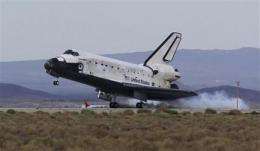Space Shuttle Discovery Returns to Earth After Successful Mission

Space shuttle Discovery and its crew of seven astronauts ended a 14-day journey of more than 5.7 million miles with an 5:53 p.m. PDT landing Friday at Edwards Air Force Base in California.
The mission, designated STS-128, delivered two refrigerator-sized science racks to the International Space Station. One rack will be used to conduct experiments on materials such as metals, glasses and ceramics. The results from these experiments could lead to the development of better materials on Earth. The other rack will be used for fluid physics research. Understanding how fluids react in microgravity could lead to improved designs for fuel tanks, water systems and other fluid-based systems.
STS-128 Commander Rick Sturckow was joined on the mission by Pilot Kevin Ford, Mission Specialists Pat Forrester, Jose Hernandez, Danny Olivas and European Space Agency astronaut Christer Fuglesang. NASA astronaut Nicole Stott flew to the complex aboard Discovery to begin a nearly three-month mission as a station resident, replacing Tim Kopra, who returned home on Discovery.
Weather concerns prevented the crew from returning to NASA's Kennedy Space Center in Florida, the primary end-of-mission landing site. In 7-10 days, Discovery will be transported approximately 2,500 miles from California to Florida on the back of a modified 747 jumbo jet. Once at Kennedy, Discovery will be separated from the aircraft to begin processing for its next flight, targeted for March 2010.
A welcome ceremony for the crew's return to Houston will be held at Ellington Field's NASA Hangar 990 at 4 p.m. CDT on Saturday, Sept. 12. The public is invited to attend.
In addition to carrying a new station crew member, Discovery and the crew also delivered a new sleeping compartment, an air purification system and a treadmill named after comedian Stephen Colbert. The mission included three spacewalks that replaced experiments outside the European Space Agency's Columbus laboratory and an empty ammonia storage tank. Ammonia is needed to move excess heat from inside the station to the radiators located outside.
Disney's toy astronaut Buzz Lightyear also returned from the space station aboard Discovery. He flew to the station in May 2008 on shuttle Discovery's STS-124 mission and served as the longest tenured "crew member" in space. While on the station, Buzz supported NASA's education outreach by creating a series of online educational outreach programs.
Provided by NASA





















